Pump Handbook by Igor J. Karassik, Joseph P. Messina, Paul Cooper, Charles C. Heald - 3rd edition
Подождите немного. Документ загружается.

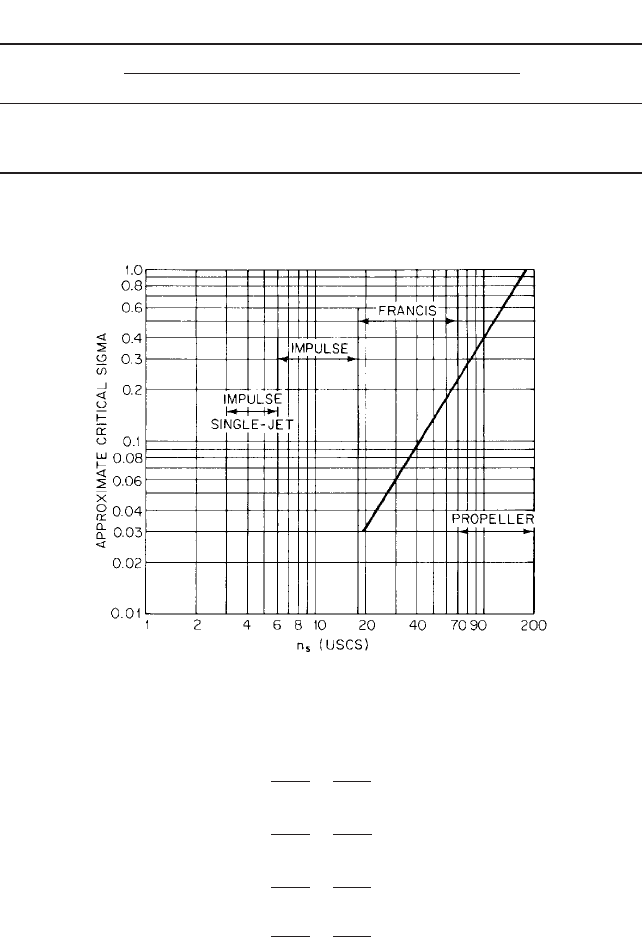
6.1.4 HYDRAULIC TURBINES 6.85
TABLE 2 Range of power, head, discharge, and speed of existing units of one
manufacturer
Propeller Francis Impulse
Low High Low High Low High
Power hp
a
82.5 268,000 1.2 820,000 1.6 330,000
Head ft
b
6.0 180 4.0 2,204 75.0 5,790
Speed, rpm 50 750 56.4 3,500 180 3,600
a
kW 0.746 hp
b
m 0.3048 ft
FIGURE 10 Critical sigma versus N
s
. Specific speed N
s
(SI) 3.814 N
s
(USCS)
Most designs used are tested as exact homologous models, and performance is stepped
up from the model by the normal affinity laws given above. Because of difficulties in mea-
suring large flows at the field installation, only approximate or relative flow metering is
normally done.
P
1
N
3
1
D
5
1
P
2
N
3
2
D
5
2
N
1
2
D
2
1
H
1
N
2
2
D
2
2
H
2
Q
1
2
H
1
D
4
1
Q
2
2
H
2
D
4
2
Q
1
N
1
D
3
1
Q
2
N
2
D
3
2
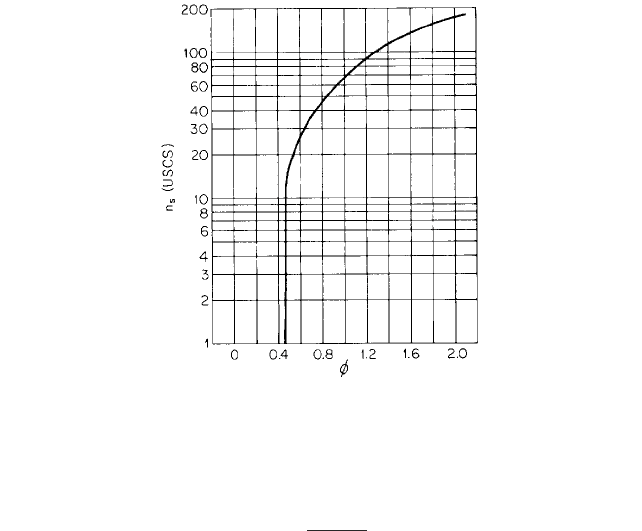
6.86 CHAPTER SIX
FIGURE 11 Specific speed versus . Specific speed N
s
(SI) 3.814N
s
(USCS)
Speed Characteristic This is defined as the peripheral speed of the runner divided by
the spouting or free discharge velocity of the water:
where f speed characteristic
u peripheral speed of runner, ft/s (m/s)
H head, ft (m)
g 32.2 ft/s
2
(9.807 m/s
2
)
A plot of f versus speed can be seen in Figure 11, which shows that f becomes constant
at after the specific speed has dropped into the impulse-runner region. Theoretically, for
maximum energy conversion, f should equal 0.5 for impulse runners. However, because
of small losses in the runner, this value is set at approximately 0.46. Control of the
hydraulic turbine can be accomplished by means of a governor or a flow or load control
system.
Torque All hydraulic turbines have maximum torque at zero speed; therefore, they have
ideal starting characteristics. The pump can be accelerated to design speed by gradually
opening the turbine gates or inlet valve while keeping within the limitations of hydraulic
transients.
DATA REQUIRED FOR TURBINE SELECTION _____________________________
The turbine supplier should have the following information in order to select the best com-
bination of size and type runner:
1. Head available, head range, and head duration.
2. Power and speed required to drive pump.
f
u
12gH2
1>2
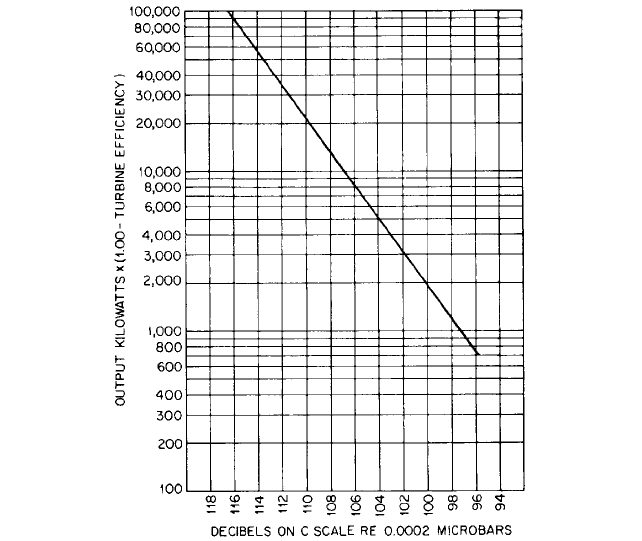
6.1.4 HYDRAULIC TURBINES 6.87
FIGURE 12 Sound level readings taken 3 ft (0.9 m) from main shaft. Hydraulic losses are approximated output
in kilowatts (1.00 turbine efficiency). (From L. F. Henry: “Selection of Reversible Pump/Turbine Specific
Speeds.” Paper presented at meeting on pumped-storage development and its environmental effects, University of
Wisconsin, September 1971.)
3. Description of fluid to be handled, including chemical composition and specific gravity.
4. Possibility of adding air to system. Turbine will operate satisfactorily without air, but
air may be added to system to reduce pressure fluctuations (normally one-third of rpm
in frequency) at part load and possibly to smooth unit operation at full load.
5. If corrosive fluid is to be handled, description of the materials required.
6. Controls from pumping process that will affect turbine operation. If speed is a con-
trolling factor, the possibility of using a speed-varying device should be considered.
7. Back pressure on the turbine.
8. Noise-level trends for the turbine. Figure 12 illustrates noise levels recorded on some
rather large turbine units. Ear protection is required for noise levels above 85 db.
FURTHER READING __________________________________________________
ASME Hydro Power Technical Committee. “The Guide to Hydropower Mechanical
Design.” HCI Publications, Inc., 1996.
Daugherty, R. U, and Ingersoll, A. C. Fluid Mechanics. McGraw-Hill, New York, 1954.
6.88 CHAPTER SIX
Henry, L. F. “Selection of Reversible Pump/Turbine Specific Speeds.” Paper presented at
meeting on pumped-storage development and its environmental effects, University of Wis-
consin, September 1971.
Roth, H. H., and Armbruster, T. F. “Starting Large Pumping Units.” Allis-Chalmers Eng.
Rev. 31 (3)(1966).
Schlichting, H. Boundary Layer Theory. McGraw-Hill, New York, 1960.
Stepanoff, A. J. Centrifugal and Axial Flow Pumps, 2nd edition. Krieger Publishing, Mal-
abar, Florida, 1957.
Warnick, C. C. “Hydropower Engineering.” Prentice Hall, New Jersey, 1984.
Wilson, P. N. “Turbines for Unusual Duties.” Water Power. June 1971.

6.1.5
GAS TURBINES
RICHARD G. OLSON
6.89
THERMODYNAMIC PRINCIPLE AND CLASSIFICATIONS ____________________
The gas turbine is an internal combustion engine differing in many respects from the stan-
dard reciprocating model. In the first place, the process by which a gas turbine operates
involves steady flow; hence pistons and cylinders are eliminated. Secondly, each part of the
thermodynamic cycle is carried out in a separate apparatus. The basic process involves
compression of air in a compressor, introduction of the compressed air and fuel into the
combustion chamber(s), and finally expansion of the gaseous combustion products in a
power turbine. Figure 1 illustrates a simple gas turbine.
The Brayton, or Joule, Cycle Figure 2 shows an ideal Brayton, or Joule, cycle illus-
trated in PV and TS diagrams.This cycle is commonly used in the analysis of gas turbines.
The inlet air is compressed isentropically from point 1 to point 2, heat is added at an
assumed constant pressure from point 2 to point 3, the air is then expanded isentropically
in the power turbine from point 3 to point 4, and finally heat is rejected at an assumed con-
stant pressure from point 4 to point 1. From Figure 2, the compressor work is h
2
h
1
, the
turbine work is h
3
h
4
, and the difference is the net work output. The heat input is h
3
h
2
. One can then derive an expression for thermal efficiency as follows:
In reality, the cycle is irreversible and the efficiency of the compression, combustion,
and expansion must be taken into account. However, an examination of the thermal effi-
ciency equation shows the need of high compressor and turbine efficiencies in order to pro-
duce an acceptable amount of work output. The importance of h
3
is also readily apparent.
h
1h
3
h
4
2 1h
2
h
1
2
h
3
h
2
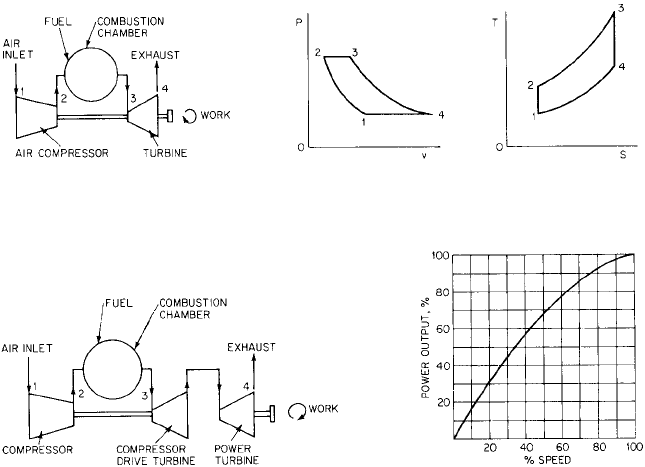
6.90 CHAPTER SIX
FIGURE 1 Components of simple gas
turbine
FIGURE 2 PV and TS diagrams for an ideal Brayton, or
Joule, cycle
FIGURE 3 Components of a split-shaft gas turbine
FIGURE 4 Typical curve of power
output versus shaft speed for a split-
shaft gas turbine
In noting that h
3
is directly proportional to temperature, one can appreciate why continu-
ous emphasis is being placed on the development of materials and techniques that permit
higher combustion temperatures and correspondingly higher turbine inlet temperatures.
Classifications In an open-cycle gas turbine, the inlet air mixes directly with the
combustion products and is exhausted to the atmosphere after passing through the
power turbine. The closed-cycle gas turbine uses a heat exchanger to transfer heat to
the working fluid, which is continuously recirculated in a closed loop. A combined cycle
uses the principles of both the open and closed cycles. In current practice, the combined
cycle uses an open cycle to provide shaft work while the heat from the exhaust is par-
tially recovered in a waste-heat boiler. The heat recovered then proceeds through a stan-
dard steam power cycle until heat is rejected to the most readily available
low-temperature reservoir.
Of the above configurations, the open-cycle gas turbine is most extensively used today
for driving centrifugal pumps.This is probably due to the important consideration of min-
imum capital investment for each power output.
Two distinct types of open-cycle gas turbines have evolved: the single-shaft and split-
shaft versions.The single-shaft gas turbine was developed primarily for the electric power
industry and uses a compressor and a power turbine integrated on a common shaft. As the
unit is used continuously at a single rotational speed, the compressor and power turbine
efficiency can be optimized.
The split-shaft gas turbine was developed primarily for mechanical drive applications
where output power and speed might be expected to vary. Figure 3 illustrates such a tur-
bine. A typical curve of power output versus shaft speed is illustrated in Figure 4.
Split-shaft gas turbines are available in conventional and aircraft-derivative versions.
The conventional gas turbine evolved from steam turbine technology and is illustrated in
6.1.5 GAS TURBINES 6.91
Figure 5. Figure 6 shows a modified jet engine used as a source of hot gas to a power tur-
bine. Note that the jet engine combines the compression, combustion, and power turbine
necessary to drive the compressor.
RATINGS____________________________________________________________
In the evolution of the gas turbine as a prime mover, various organizations have put forth
standard conditions of inlet temperature and elevation to allow direct comparison of var-
ious gas turbines.
Four common standards exist:
ISO (International Standards Organization): sea level and 59°F (15°C)
NEMA (National Electrical Manufacturers Association): 1000 ft (304.8 m) above sea
level and 80°F (27°C)
CIMAC (Congres International des Machines a Combustion): sea level and 59°F (15°C)
Site: actual elevation and design temperature at installation site
With the evolution of higher combustion temperatures and with the greater need for
power over relatively short daily periods, new ratings have developed: emergency (maxi-
mum intermittent), peaking (intermittent), and base load. These classifications are based
on the number of hours per unit of time that a gas turbine is operated and are related to
the material used in the power turbine blading. A common standard is to use materials
suitable for 100,000 h of continuous operation. Higher temperatures are permitted, but at
the sacrifice of the life of the material and an increase in maintenance costs.
In a pump-driving application, the cycle of operations should be considered in specify-
ing a gas turbine driver. A typical curve of gas turbine output as a function of inlet tem-
perature (Figure 7) clearly indicates the necessity of specifying an accurate design
temperature. Figure 8 is a typical correction curve for altitude.
FUELS______________________________________________________________
A wide range of fuels, from natural gas to the bunker oils, may be burned in simple-cycle
gas turbines. In most cases, units can operate on gas or liquid fuels, and some turbines
have automatic switchover capability while under load.
Although it would appear advantageous to choose the cheapest fuel available, there
may be disadvantages in such a choice: impurities such as vanadium, sulfur, and sodium
definitely result in high-temperature corrosion; solid impurities and a high ash content
will lead to erosion problems. One is therefore often faced with a trade-off between the cost
of treating a fuel and the higher original cost.
With ever-increasing firing temperatures, research is continuing in the field of high-
temperature corrosion with or without accompanying erosion problems. Present
approaches to the problem include the use of inhibitors in the fuel as well as coatings for
power turbine blades. Another solution that has been used on some crude oil pipelines is
the topping unit. This is a small still that removes a specific fraction of the crude oil for
burning as gas turbine fuel. It is good practice to include a detailed fuel analysis as part
of any request for bids.
ENVIRONMENTAL CONSIDERATIONS ___________________________________
Legislation at both the federal and state levels has been concerned with the protection of our
environment. An engineer must now consider the effects of the project on the environment.
Noise Any piece of dynamic mechanical equipment will emit airborne sounds that,
depending on frequency and level, may be classified as noise.

6.92
FIGURE 5 Gas turbine cross section: (1) gas generator turbine rotor, (2) inlet air casing, (3) compressor inlet guide vanes, (4) conical inlet casing with bearing support, (5) compressor
radial-axial bearing, (6) compressor stator, (7) compressor stator blades, (8) compressor rotor blades, (9) combustion chamber main casing, (10) intermediate conical casing with diffuser,
(11) gas generator turbine stator blade carrier
, (12) gas generator turbine stator blades, (13) gas generator turbine rotor blades, (14) hot gas casing, (15) intermediate casing, (16) nine
incorporated combustion chambers, (17) compressor radial bearing, (18) central casing, (19) power turbine rotor, (20) power turbine stator blades, (21) power turbine rotor blades, (22)
power turbine adjustable rotor blades, (23) power turbine stator blade carrier, (24) conical intermediate piece, (25) outlet diffuser, (26) outlet casing, (27) power turbine radial-axial bearing,
(28) power turbine radial bearing, (29) metallic foundation (Turbodyne)
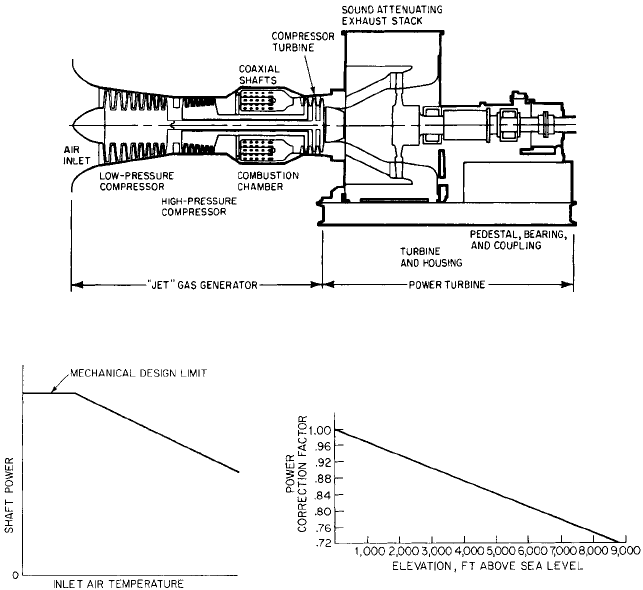
6.1.5 GAS TURBINES 6.93
FIGURE 8 Typical curve of gas turbine power correction
versus altitude (ft 0.3048 = m)
FIGURE 6 Cross section of aircraft-derivative gas turbine driver (Turbodyne)
FIGURE 7 Typical curve of gas turbine
output versus inlet temperature
The primary sources of noise in the gas turbine are the turbine inlet and exhaust and
the accessories and support systems, such as fin fan lubrication oil coolers, auxiliary air
blowers and fans, starting devices, and auxiliary lubrication oil pumps. It is common prac-
tice for manufacturers to provide inlet and exhaust silencers as well as some form of
acoustic treatment for auxiliaries.
In considering the degree of acoustic treatment necessary for each installation, the
practicing engineer must consider the following parameters:
1. Federal law (Walsh-Healy Act) limiting the time a worker may spend in a noisy
environment
2. Local codes and their interpretation
3. Plant location and existing noise level at site
4. Site topography, including any noise-reflective surfaces
5. Applicable ASME standards and other relevant standards
Emissions The federal air quality acts require each state to develop a plan for
achieving satisfactory air quality. Specifically, goals have been put forth to limit sus-
pended particulate temperature matter and oxides of sulfur and nitrogen. Therefore,
6.94 CHAPTER SIX
the engineer must investigate existing regulations during the planning stage of a pump
installation.
In general, gas turbines have low particulate emissions. The amount of sulfur oxides
exhausted to the atmosphere is in direct proportion to the content of sulfur in the fuel, and
current practice calls for elimination at the source. The formation of oxides of nitrogen is
a direct result of combustion. Manufacturers are currently committing a considerable
amount of resources to the investigation and solution of this problem.
GAS TURBINE SUPPORT SYSTEMS _____________________________________
Starting Systems
A form of mechanical cranking is necessary to bring a gas turbine
up to its self-sustaining speed. The amount of energy necessary will depend on each man-
ufacturer’s design. Available systems include electric motors, diesel engines, and gas-
expander turbines.
Lubrication The gas turbine manufacturer normally provides a combined pump-
turbine lubrication oil system. A main lubrication oil pump of sufficient capacity for the
combined system is necessary, in addition to a standby pump in the event of failure of
the main pump. A reservoir sized for a retention time of at least four minutes is usu-
ally specified. Filtration to 10-mm particle size should be adequate for most gas turbines
and pumps.
Lubrication oil can be cooled by various means, the selection of which depends upon
local conditions. The simplest and cheapest method uses a shell-and-tube heat exchanger
with water as the cooling medium. In arid regions, a fin fan cooler with direct air-to-water
cooling is commonly used.
Inlet Air Filtration The degree of inlet air filtration needed is primarily a function of
the size and number of particles in the atmosphere surrounding the installation. In most
cases, a simple tortuous-path precipitator will suffice. For dirtier atmospheres or in arid
regions where sandstorms occur, inertial separators followed by a rolling-media filter
should be considered.
Any filtration will result in a loss in performance because of the pressure drop across the
inlet filter. Conservative design practice calls for a face velocity of 500 ft/min (150 m/min)
for a rolling-media filter and 1700 ft/min (520 m/min) for a tortuous-path precipitator.
Control Most manufacturers offer control packages which provide proper sequencing for
automatic start-up, operation, and shutdown. During automatic start-up, the sequencer
receives signals from various transmitters to ensure that auxiliaries are functioning prop-
erly and, with the aid of timers, brings the unit on line through a planned sequence of events.
Key operating parameters
—
for example, output speed, gas turbine compressor speed, tur-
bine inlet temperature, lubrication oil temperature and pressure
—
are continually monitored
during normal operation. Signals from a pump discharge-pressure transmitter can be fed
into a speed and fuel controller to cause the unit to respond to changes in speed and output.
As with start-up, normal and emergency shutdowns are accomplished through the
sequencer. Most standard control packages are easily adaptable to remote control by
means of cable or microwave.
APPLICATION TO PUMPS______________________________________________
Gas turbines are available to drive centrifugal pumps in a wide range of speeds and sizes,
from 40 bp (30 kW) to over 20,000 hp (15,000 kW). It is not practical to list here all the avail-
